AMD Dives Deep On High Bandwidth Memory - What Will HBM Bring AMD?
by Ryan Smith on May 19, 2015 8:40 AM ESTThe Net Benefits of HBM
Now that we’ve had a chance to talk about how HBM is constructed and the technical hurdles in building it, we can finally get to the subject of the performance and design benefits of HBM. HBM is of course first and foremost about further increasing memory bandwidth, but the combination of stacked DRAM and lower power consumption also opens up some additional possibilities that could not be pursued with GDDR5.
We’ll start with the bandwidth capabilities of HBM. The amount of bandwidth ultimately depends on the number of stacks in use along with the clockspeed of those stacks. HBM uses a DDR signaling interface, and while AMD is not disclosing final product specifications at this time, they have given us enough information to begin to build a complete picture.
| GPU Memory Math | |||||
| AMD Radeon R9 290X | NVIDIA GeForce GTX Titan X | Theoretical 4-Stack HBM1 | |||
| Total Capacity | 4GB | 12GB | 4GB | ||
| Bandwidth Per Pin | 5Gbps | 7Gbps | 1Gbps | ||
| Number of Chips/Stacks | 16 | 24 | 4 | ||
| Bandwidth Per Chip/Stack | 20GB/sec | 14GB/sec | 128GB/sec | ||
| Effective Bus Width | 512-bit | 384-bit | 4096-bit | ||
| Total Bandwidth | 320GB/sec | 336GB/sec | 512GB/sec | ||
| Estimated DRAM Power Consumption |
30W | 31.5W | 14.6W | ||
The first generation of HBM AMD is using allows for each stack to be clocked up to 500MHz, which after DDR signaling leads to 1Gbps per pin. For a 1024-bit stack this means a single stack can deliver up to 128GB/sec (1024b * 1G / 8b) of memory bandwidth. HBM in turn allows from 2 to 8 stacks to be used, with each stack carrying 1GB of DRAM. AMD’s example diagrams so far (along with NVIDIA’s Pascal test vehicle) have all been drawn with 4 stacks, in which case we’d be looking at 512GB/sec of memory bandwidth. This of course is quite a bit more than the 320GB/sec of memory bandwidth for the R9 290X or 336GB/sec for NVIDIA’s GTX titan X, working out to a 52-60% increase in memory bandwidth.
At the same time this also calls into question memory capacity – 4 1GB stacks is only 4GB of VRAM – though AMD seems to be saving that matter for the final product introduction later this quarter. Launching a new, high-end GPU with 4GB could be a big problem for AMD, but we'll see just what they have up their sleeves in due time.
What’s perhaps more interesting is what happens to DRAM energy consumption with HBM. As we mentioned before, R9 290X spends 15-20% of its 250W power budget on DRAM, or roughly 38-50W of power on an absolute basis. Meanwhile by AMD’s own reckoning, GDDR5 is good for 10.66GB/sec of bandwidth per watt of power, which works out to 30W+ via that calculation. HBM on the other hand delivers better than 35GB/sec of bandwidth per watt, an immediate 3x gain in energy efficiency per watt.
Of course AMD is then investing some of those gains back in to coming up with more memory bandwidth, so it’s not as simple as saying that memory power consumption has been cut by 70%. Rather given our earlier bandwidth estimate of 512GB/sec of memory bandwidth for a 4 stack configuration, we would be looking at about 15W of power consumption for a 512GB/sec HBM solution, versus 30W+ for a 320GB/sec GDDR5 solution. The end result then points to DRAM power consumption being closer to halved, with AMD saving 15-20W of power.
What’s the real-world advantage of a 15-20W reduction in DRAM power consumption? Besides being able to invest that in reducing overall video card power consumption, the other option is to invest it in increasing clockspeeds. With PowerTune putting a hard limit on power consumption, a larger GPU power budget would allow AMD to increase clockspeeds and/or run at the maximum GPU clockspeed more often, improving performance by a currently indeterminable amount. Now as fair warning here, higher GPU clockspeeds typically require higher voltages, which in turn leads to a rapid increase in GPU power consumption. So although having additional power headroom does help the GPU, it may not be good for quite as much of a clockspeed increase as one might hope.
Meanwhile the performance increase from the additional memory bandwidth is equally nebulous until AMD’s new product is announced and benchmarked. As a rule of thumb GPUs are virtually always memory bandwidth bottlenecked – they are after all high-throughput processors capable of trillions of calculations per second working with only hundreds of billions of bytes of bandwidth – so there is no doubt that the higher memory bandwidths of HBM will improve performance. However memory bandwidth increases currently don’t lead to 1:1 performance increases even on AMD’s current cards, and it’s unlikely to be any different on future products.
Throwing an extra wrinkle into matters, any new AMD product would be based on GCN 1.2 or newer, which introduced AMD’s latest generation of color compression technology. The net result is that on identical workloads, memory bandwidth pressure is going down exactly at the same time as memory bandwidth availability is going up. AMD will end up gaining a ton of effective memory bandwidth – something that will be very handy for high resolutions – but it also makes it impossible to predict what the final performance impact might be. Still, it will be interesting to see what AMD can do with a 2x+ increase in effective memory bandwidth for graphics workloads.
The final major benefit AMD is looking at taking advantage of with HBM – and that this point they’re not even being subtle about – is new form factor designs from the denser designs enabled by HBM. With the large GDDR5 memory chips replaced with much narrower HBM stacks, AMD is telling us that the resulting ASIC + RAM setups can be much smaller.
How much smaller? Well 1GB of GDDR5, composed of 2Gbit modules (the standard module size for R9 290X) would take up 672mm2, versus just 35mm2 for the same 1GB of DRAM as an HBM stack. Even if we refactor this calculation for 4Gbit modules – the largest modules used in currently shipping video cards – then we still end up with 336mm2 versus 35mm2, which is still a savings of 89% for 1GB of DRAM. Ultimately the HBM stack itself is composed of multiple DRAM dies, so there’s still quite a bit of silicon in play, however its 2D footprint is reduced significantly thanks to stacking.
By AMD’s own estimate, a single HBM-equipped GPU package would be less than 70mm X 70mm (4900mm2), versus 110mm X 90mm (9900mm2) for R9 290X. Throw in additional space savings from the fact that HBM stacks don’t require quite as complex power delivery circuitry, and the card space savings could be significant. By our reckoning the total card size will still be fairly big – all of those VRMs and connectors need to go somewhere – but there is potential for significant savings. What AMD intends to do with those savings remains to be seen, but with apologies to AMD on this one, NVIDIA has already shown off their Pascal test vehicle for their mezzanine connector design, and it goes without saying that such a form factor opens up some very interesting possibilities.
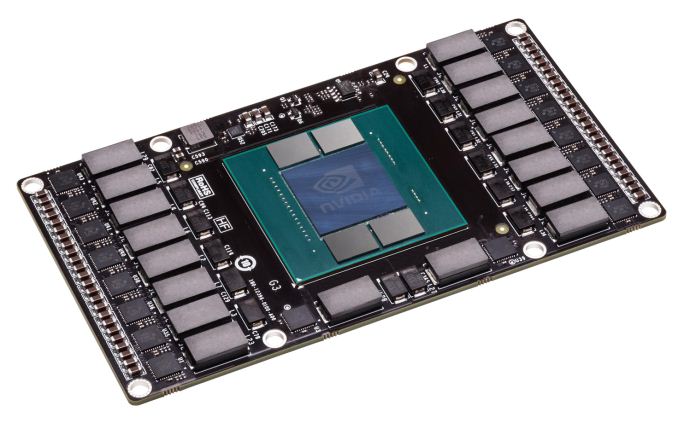
With apologies to AMD: NVIDIA’s Pascal Test Vehicle, An Example Of A Smaller, Non-Traditional Video Card Design
Finally, aftermarket enthusiasts may or may not enjoy one final benefit from the use of HBM. Because the DRAM and GPU are now on the same package, AMD is going to be capping the package with an integrated heat spreader (IHS) to compensate for any differences in height between the HBM stacks and GPU die, to protect the HBM stacks, and to supply the HBM stacks with sufficient cooling. High-end GPU dies have been bare for some time now, so an IHS brings with it the same kind of protection for the die that IHSs brought to CPUs. At the same time however this means it’s no longer possible to make direct contact with the GPU, so extreme overclockers may come away disappointed. We’ll have to see what the shipping products are like and whether in those cases it’s viable to remove the IHS.
Closing Thoughts
Bringing this deep dive to a close, as the first GPU manufacturer to be shipping an HBM solution – in fact AMD expects to be the only vendor to ship an HBM1 solution – AMD has set into motion some very aggressive product goals thanks to the gains from HBM. Until we know more about AMD’s forthcoming video card I find it prudent to keep expectations in check here, as HBM is just one piece of the complete puzzle that is a GPU. But at the same time let’s be clear here: HBM is the future memory technology of GPUs, there is potential for significant performance increases thanks to the massive increase in memory bandwidth offers, and for roughly the next year AMD is going to be the only GPU vendor offering this technology.
AMD for their part is looking to take as much of an advantage of their lead as they can, both at the technical level and the consumer level. At the technical level AMD has said very little about performance so far, so we’ll have to wait and see just what their new product brings. But AMD is being far more open about their plans to exploit the size advantage of HBM, so we should expect to see some non-traditional designs for high-end GPUs. Meanwhile at the consumer level, expect to see HBM enter the technology lexicon as the latest buzzword for high-performance products – almost certainly to be stamped on video card boxes today just as GDDR5 has been for years – as AMD looks to let everyone know about their advantage.
Meanwhile shifting gears towards the long term, high-end GPUs are just the first of what AMD expects to be a wider rollout for HBM. Though AMD is not committing to any other products at this time, as production ramps up and costs come down, HBM is expected to become financially viable in a wider range, including lower-end GPUs, HPC products (e.g. FirePro S and AMD’s forthcoming HPC APU), high-end communications gear, and of course AMD’s mainstream consumer APUs. As lower-margin products consumer APUs will likely be among the farthest off, however in the long-run they may very well be the most interesting use case for HBM, as APUs are among the most bandwidth-starved graphics products out there. But before we get too far ahead of ourselves, let’s see what AMD is able to do with HBM on their high-end video cards later this quarter.


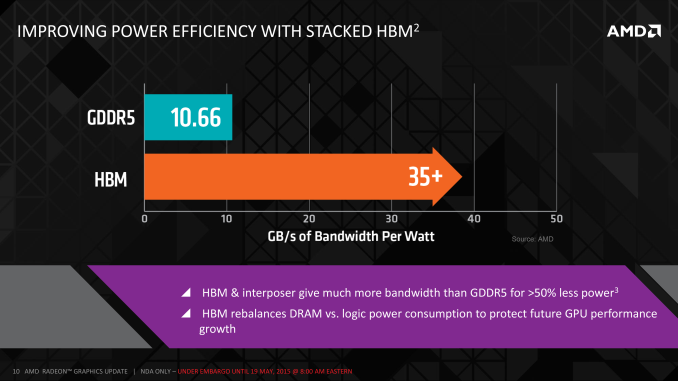
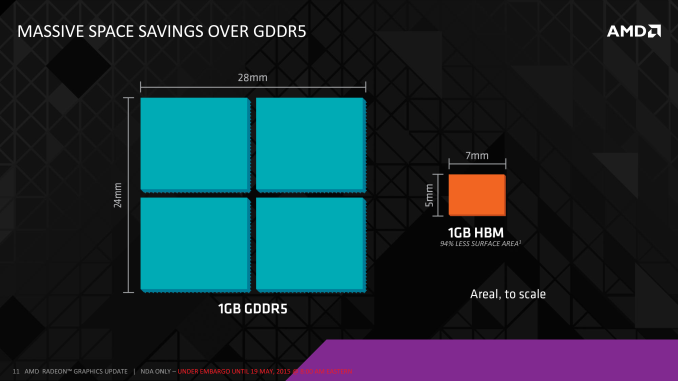
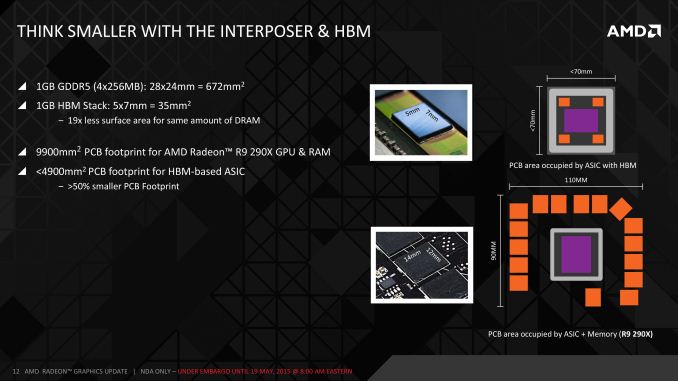
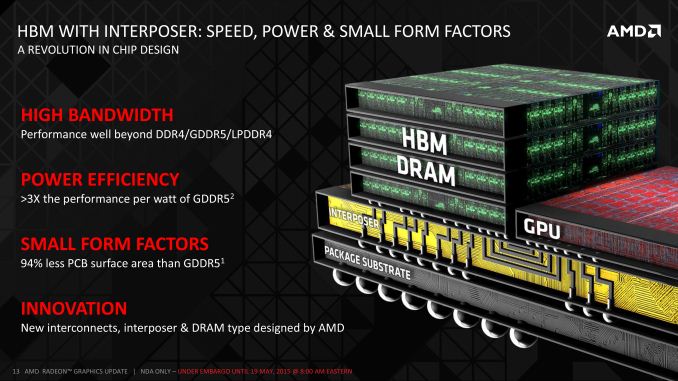








163 Comments
View All Comments
WinterCharm - Tuesday, May 19, 2015 - link
Exactly. And science and common sense have shown again and again, if you eliminate the bottlenecks, you can get significant performance gains.That's why SSD's are so great.
AndrewJacksonZA - Thursday, May 28, 2015 - link
What @dew111 said.i7 - Tuesday, May 19, 2015 - link
Wouldn't you see higher memory configs much like the 970 memory config 'fiasco' with greater than 4GB on another substrate or another entirely different configuration?dew111 - Tuesday, May 19, 2015 - link
No. The current HBM stacks come in a fixed capacity, and the Fiji chip will only have so many lanes. Also, it is unlikely an OEM would venture into designing (and funding) their own interposer; this probably won't happen for at least a few years (if ever).akamateau - Monday, June 8, 2015 - link
Actually an OEM can not design an Interposer with a memory controller. AMD owns that patent.Interposer having embedded memory controller circuitry
US 20140089609 A1
" For high-performance computing systems, it is desirable for the processor and memory modules to be located within close proximity for faster communication (high bandwidth). Packaging chips in closer proximity not only improves performance, but can also reduce the energy expended when communicating between the processor and memory. It would be desirable to utilize the large amount of "empty" silicon that is available in an interposer. "
AMD has pretty sewn up the concept of an Interposer being just a substarte with vias to stack and connect silicon.
Besides it would also be unlikely for OEM to be able to purchase unpackaged cpu or memory silicon for their own stacks. And why? Their manfacturing costs would be far higher
eachus - Friday, May 22, 2015 - link
Don't forget the HBM1 vs. HBM2 change/upgrade that is coming. Will HMB2 show up late this year? Or early next year? Your guess. AMD will then be able to ship cards with twice the bandwidth--and four times the memory. My guess is that AMD plans a "mid-life kicker" for Fiji later this year taking it to 8 GBytes but still at HBM1 clock speeds. Then Greenland comes along with 16 Gig and HBM2 speeds.BTW don't knock the color compression technology. It makes (slightly) more work for the GPU, but reduces memory and bandwidth requirements. When working at 4K resolutions and beyond, it becomes very significant.
chizow - Tuesday, May 19, 2015 - link
GTA5 does go over 4GB at 1440p, as do a number of other next-gen games like Assassin's Creed Unity, Shadows of Mordor, Ryse, I am sure Witcher 3 does as well. 6GB is probably safe for this gen until 14/16nm FinFET, 8GB safest, 12GB if you want no doubts. We also don't know what DX12 is going to do to VRAM requirements.Its not about fitting the actual frame buffer, its about holding and storing textures locally in VRAM so that the GPU has access them without going to System RAM or worst, local storage. Hi-Res 4K and 8K textures are becoming more common which increases storage footprint 4 fold and 16 fold over 2K, so more VRAM is always going to be welcome.
silverblue - Tuesday, May 19, 2015 - link
That compression had better be good, then.testbug00 - Tuesday, May 19, 2015 - link
According to NVidia, without gameworks, 1440p at max settings 980 is the recommended card. And with gameworks Titan X/SLI 970.2160p w/out gameworks recommend Titan X/SLI 980. Even at 2160p w/ Gameworks they still recommend 980 SLI.
Based on that my WAG is that TWIII uses under 4GB of VRAM at 2160. I'm guessing bringing Gameworks in pushes it just near the 4GB limit on 980. Probably in the 39xx range.
chizow - Tuesday, May 19, 2015 - link
Can't say for sure as I don't have TW3 yet, but based on screenshots I wouldn't be surprised at all to see it break 4GB. In any case, games and drivers will obviously do what they can to work around any VRAM limitations, but as we have seen, it is not an ideal situation. I had a 980 and 290X long enough to know there were plenty of games dancing close enough to that 4GB ceiling at 1440p to make it too close for comfort.